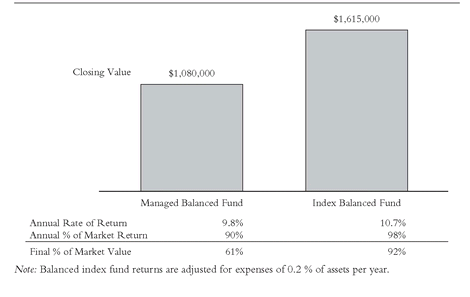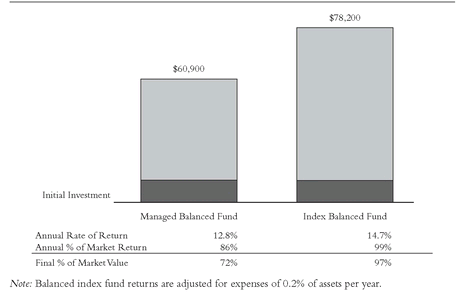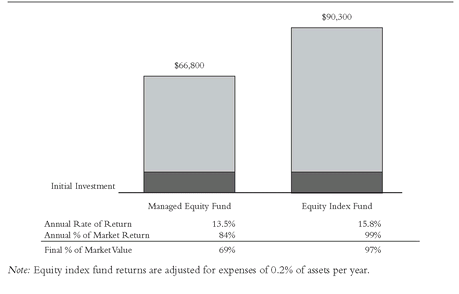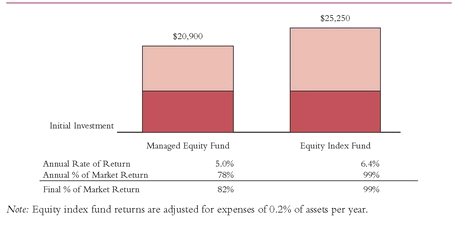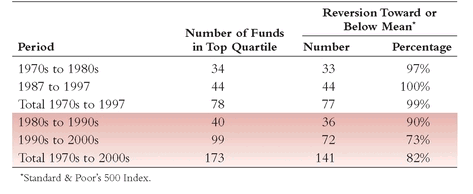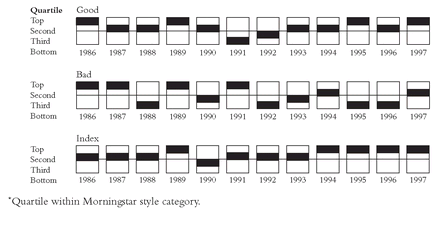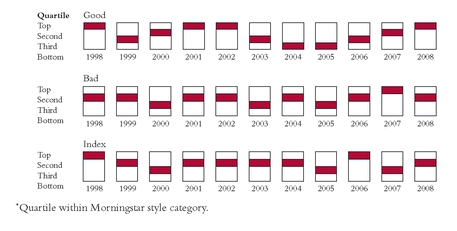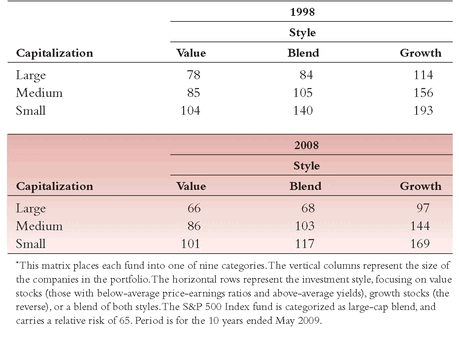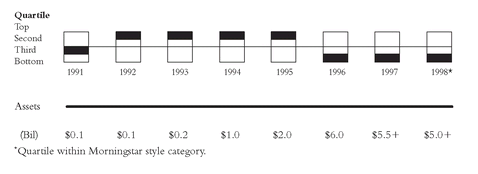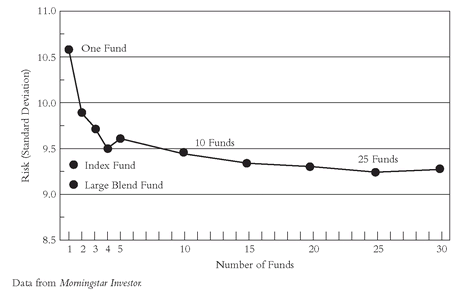Chapter 4
On Simplicity
How to Come Down to Where You Ought to Be
We live in a world where a seemingly infinite amount of information is available to just about everyone. Financial facts, figures, and theories once available only to investment professionals are now at the fingertips of individual investors. No longer must the investor depend on the services of an investment professional. Buy and sell to your heart’s content over the World Wide Web. The information age has truly transformed the world of investing.
Today, investors are bombarded on all sides by investment information—whether they want it or not. Complex quantitative analysis, real-time stock quotes, and the like are available at any local library, if not through a personal computer. Investors now ask their mutual fund managers about their “alpha”; they want to know a fund’s “Sharpe ratio”; they read articles about “complexity theory” and “behavioral finance.”
Yet this barrage of information has not necessarily translated into better returns. Instead, we focus on the quantity of data. We want more sophisticated and complex information. Presumably it will enhance our returns. Our world may or may not be any more complex than it has ever been, but we have certainly made the investment process more complicated. In today’s environment of a mind-numbing information flow that is at once electrifying and terrifying, where is the intelligent investor to turn?
Turn to simplicity. The great paradox of this remarkable age is that the more complex the world around us becomes, the more simplicity we must seek in order to realize our financial goals. Never underrate either the majesty of simplicity or its proven effectiveness as a long-term strategy for productive investing. Simplicity, indeed, is the master key to financial success. The old Shaker hymn got it just right:
’Tis the gift to be simple;
’Tis the gift to be free;
’Tis the gift to come down
Where we ought to be.
I’d like to offer some precepts to help you “come down where [you] ought to be” in your quest for investment success. Let me begin by describing what I regard as the realistic epitome of investment success. Here is my definition of the nature of the task: The central task of investing is to realize the highest possible portion of the return earned in the financial asset class in which you invest—recognizing, and accepting, that that portion will be less than 100 percent.
Why? Because of cost. As we have already seen, we must pay the costs of the intermediaries involved in making the investments in each financial asset class—cash reserves, bonds, stocks, and so on—available to us. To state the obvious, we know intuitively that our certificates of deposit and our money market funds will inevitably earn less than the going market rate for short-term commercial paper, simply because the costs of financial intermediaries—transaction costs, information costs, and the cost of convenience—are deducted from the interest rates paid by the government or by the corporate borrower.
Similarly, we do not—nor should we—expect our bond funds to provide us with higher yields than the average yield of the bonds held in a fund’s portfolio. In fact, because of excessive fund fees in bond mutual funds as a group, the gap between 100 percent of the market return and the return that filters down to the investor after cost is often distressingly large—so large that nearly all bond funds are distinctly inferior investments.
The proposition applies even in the equity arena, the third major class of liquid financial assets. It is a mathematical impossibility—a definitional contradiction—for all investors as a group to outpace the returns that are earned in the total stock market. Indeed, given the high costs of equity fund ownership, it is a mathematical certainty that, over a lifetime of investing, only a handful of fund investors will succeed in doing so by any significant margin.
TEN YEARS LATER
The Value of Simplicity
The baneful trends that I warned of a decade ago have intensified, commensurately raising the need for greater simplicity in our investment affairs (and probably in our lives and our careers as well!). The remarkable complexity of the insanely risky financial instruments that brought our financial system and our economy to their knees—all those off-books structured investment vehicles (SIVs), collateralized debt obligations (CDOs), and credit default swaps (CDSs)—only confirms the need for the kind of clarity, transparency, and simplicity that I recommended to investors then, and continue to recommend now.
When All Else Fails, Fall Back on Simplicity
I propose to challenge most of the conventional wisdom that you hear and read. A considerable amount of good common sense is available to investors. Pay attention to it. But a considerable amount of foolishness—investment wizardry, financial legerdemain, and tempting solutions—is also promoted, often by the apparently omniscient. Disregard it. No matter what you hear or read, do not forget that we live and invest today in an uncertain world of finance, of volatile and interrelated securities markets. You may have heard that we are living in a new era, but I strongly caution you that, in human history, many more “new eras” have been predicted than have ever come to pass.
Amid the cacophony of advice bombarding you, mine, I imagine, is the most basic: To earn the highest of returns that are realistically possible, you should invest with simplicity. Accepting this reality—that investors as a group will inevitably capture less than 100 percent of the rates of return provided in any asset class—is the first step toward simplifying investment decisions. What, then, is the optimal method of approaching the 100 percent target and accumulating a substantial investment account? Rely on the ordinary virtues that intelligent, balanced human beings have relied on for centuries: common sense, thrift, realistic expectations, patience, and perseverance. In investing, I assure you that those characteristics will, over the long run, be rewarded.
Where should you begin? Consider that the ultimate in simplicity comes with the additional virtue of low cost. The simplest of all approaches is to invest solely in a single balanced market index fund—just one fund. And it works. Such a fund offers a broadly diversified middle-of-the-road investment program for a typical conservative investor who is investing about 65 percent of assets in stocks and 35 percent in bonds. This portfolio is entirely indexed—that is, its stocks and bonds are not actively managed, but simply represent a broad cross section of the entire U.S. stock market and bond market. (The next chapter explores this concept in considerable depth.) Over the past half-century, such a fund would have captured 98 percent of the rate of return of the combined stock and bond markets. Investing doesn’t get much better than that.
Let me prove the point by evaluating the cumulative returns of balanced mutual funds—a group whose portfolios tend to be quite homogeneous, composed as they are of stocks with both value and growth characteristics, and good-quality bonds with intermediate-to-long maturities (usually including a small cash reserve). I’ll compare the cumulative returns of the average balanced fund with a hypothetical no-load balanced index fund weighted 35 percent by the Lehman High-Grade Corporate Bond Index and 65 percent by the Standard & Poor’s 500 Stock Index (rebalanced annually), with the annual return reduced by estimated costs of 0.2 percent. We’ll take a half-century retrospective, in order to gain a broad view from the lessons of history.
Figure 4.1 shows the results, based on an initial investment of $10,000 in 1947.
FIGURE 4.1 Owning a Single Balanced Fund, 50-Year Results, 1947 to 1997, $10,000 Investment
TEN YEARS LATER FIGURE 4.1 Owning a Single Balanced Fund, 50-Year Results, 1958 to 2008, $10,000 Investment
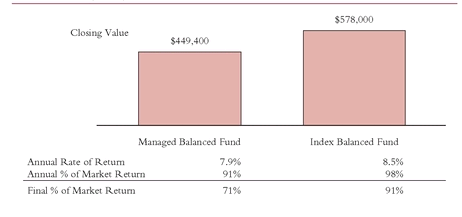
Note these three key observations:
1. At the end of the half-century, the initial $10,000 investment would have grown to $1,615,000 for the passively managed index fund, versus $1,080,000 for the actively managed traditional fund—a compound annual return of 10.7 percent, compared to 9.8 percent for the average balanced fund (and 10.9 percent for the composite index itself). When time and compounding join forces, this seemingly modest 0.9 percent advantage in annual return for the index fund over the average actively managed fund has created a profound difference in accumulated wealth—fully $535,000. Little things mean a lot.
2. The superiority of the index fund is not a matter of magic. The heavy costs of managed funds accounted for precisely 100 percent of the differential in rate of return. The average balanced fund incurred annual operating expenses of 0.9 percent, on average, during the period, and perhaps another 0.2 percent in portfolio turnover costs—a total handicap of 1.1 percent. The index fund cost was 0.2 percent, an advantage of 0.9 percent. That cost advantage is what made the difference.
3. While managed funds earned annual returns equal to 90 percent of the market returns for a 65/35 stock/bond portfolio, at the end of 50 years the final value was just 61 percent of the value of the market portfolio. For the balanced index fund, however, the final value was 92 percent of that of the market portfolio, more than half again as large as the managed funds.
Fifty years, to be sure, is a long time. The past 15 years may be more relevant for appraising today’s fund industry, so let’s look at the 35 balanced funds that have survived that period (
Figure 4.2). As it turns out, you would have been wise not to waste your energy trying to find the best manager.
Only two funds outpaced the low-cost index fund for the full period. During the past 15 years—including most of the bull market, with stock returns near historic highs—the average return of the actively managed balanced funds was 12.8 percent per year, compared with 14.7 percent for the balanced index fund, without a noticeable difference in risk. That 1.9 percent deficit may not matter to investors when they still earn 12.8 percent net, but when stock returns recede to more normal levels—as they are apt to—the deficit’s significance will be more apparent.
This 1.9 percent relative advantage in recent times was more than double the 0.9 percent advantage over the half-century, and probably a better portent of things to come. The net results: $10,000 grew to $78,200 in the index fund versus $60,900 in the managed fund. The index fund advantage alone was $17,300—almost double the initial capital. And, this time, with the higher 14.9 percent return on the index itself, the index fund, with an annual cost of 0.2 percent, captured fully 99 percent of the market rate of return. Investing in a single balanced index fund represents not only the ultimate in simplicity, but a productive choice as well.
FIGURE 4.2 Owning a Single Balanced Fund, 15-Year Results, June 1983 to June 1998, $10,000 Investment
TEN YEARS LATER FIGURE 4.2 Owning a Single Balanced Fund, 15-Year Results, 1993 to 2008, $10,000 Investment
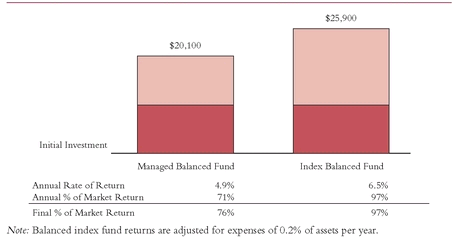
TEN YEARS LATER
Simplicity in Balanced Funds
The boxcar accumulations of balanced funds over a half-century have of course come down to earth. That’s what happens when we replace the first 10 wonderful years of the period with the dismal results of the past 10 years. But the margin of advantage for the passively managed balanced index fund over its actively managed peers remains virtually unchanged—an advantage of 0.6 percent per year versus 0.9 percent in the earlier era. The principal (and utterly predictable) reason for that advantage remains the same: the substantial cost advantage of the index fund, largely reflected in its lower expense ratio—0.2 percent versus 1.0 percent for its peers, an annual enhancement of 0.8 percent, repeated year after year.
Over the past 15 years, this advantage in return, as it happens, was even larger, even though, given the low stock market returns of that period, both total returns had shrunk substantially. While the average managed balanced fund produced an annual return of just 4.9 percent, the passive balanced index fund again did much better, earning a 6.5 percent annual return. And again, this performance can be primarily attributed to the huge advantage the balanced index fund enjoyed by minimizing its operating expense ratio. Surely, given the dismal market conditions of the past decade, 6.5 percent is a more-than-acceptable return, and a reminder that by balancing the (usually) stable returns of bonds with the (usually) far more volatile returns of stocks, the balanced fund continues to play a remarkably useful role for conservative investors.
Remarkably, despite the dramatic change in market conditions, the cumulative compound return of the balanced index fund relative to the return of the balanced index remained unchanged—97 percent in both 15-year periods. The average managed balanced fund earned only 72 percent in the first period, and only a barely improved 76 percent in the second.
Simplicity in Your Stock Portfolio
Like most people, you may well be an investor who would like to control your own investment balance. Fair enough. I turn now to a second example of the value of simplicity—a single
equity index fund for your stock portfolio. Again, during the past 15 years, the record of indexing has been truly remarkable. The total stock market index (Wilshire 5000) has outpaced the average diversified equity fund by 2.5 percentage points per year. Again, the index fund captured 99 percent of the annual market return of 16.0 percent. The cumulative result is really quite imposing, with an
added return of more than $23,500—more than two times the value of the initial investment (see
Figure 4.3). This difference arises largely because
total fund costs (expense ratios plus portfolio transaction costs) themselves ran to about two full percentage points.
As was the case with the balanced funds (only more so), this 15-year equity fund comparison amply justified a simple index approach to capturing the highest realistically possible portion of the market’s returns—albeit slightly less than 100 percent.
What I have described here is the very essence of simplicity: owning the entire U.S. stock market (and, for a balanced index fund, the entire U.S. bond market as well); making no effort to select the best manager; holding the asset allocation constant and making no attempt at market timing; keeping transaction activity low (and minimizing taxes as well); and eliminating the excessive costs of investing that characterize managed mutual funds. And it worked. Even if future outcomes of this approach are less successful, it’s hard to imagine that they could provide markedly inferior wealth accumulation relative to comparable managed funds. The success of the index fund reaffirms a basic piece of investment wisdom: When all else fails, fall back on simplicity.
Ever the realist, I recognize that few expect that “all else will fail.” In the real world, lots of all-too-human traits get in the way of a simple, all-encompassing index fund approach:
“Hope springs eternal.”
“I’ m better than average.”
“Even if the game is expensive, it’s fun.”
FIGURE 4.3 Owning a Single Equity Fund, 15-Year Results, June 1983 to June 1998, $10,000 Investment
TEN YEARS LATER FIGURE 4.3 Owning a Single Equity Fund, 15-Year Results, 1993 to 2008, $10,000 Investment
“That example is too good to be true.”
“It can’t be that simple.”
These are common refrains in the words and thoughts of investors who choose to pursue the conventional strategy of relying entirely on actively managed funds to implement their investment strategies.
TEN YEARS LATER
Simplicity in Equity Funds
Given the market conditions of the recent era, it is hardly surprising that the balanced index fund actually outpaced an all- equity index fund (in this case, a fund based on the S&P 500 Index). While the return on the equity index fund came close (6.4 percent per year versus the 6.5 percent for the balanced index fund), it assumed far higher risks by investing 100 percent in equities versus just 65 percent for the balanced fund. Surely the fact that those patterns of advantage for index funds repeat themselves over multiple periods of varying length, and in both equity-only and balanced stock/bond strategies, confirms with data precisely what our instincts tell us: Yes, costs matter!
If You Decide Not to Index . . .
But if the beginning of simplicity is the index fund, it need not be the end. History suggests that, in the long run, only one of every five actively managed funds is apt to outpace the market index (after taxes, only one of seven). And some simple commonsense principles should help you to select them and to earn a generous portion of the market’s return—again, all too likely, less than 100 percent. If there are long odds against outpacing the market, going about the task of fund selection intelligently can at least help to guard against a significant failure. Even master investor Warren Buffett, a strong proponent of the index approach, concedes that there may be other ways to construct an investment portfolio:
Should you choose . . . to construct your own portfolio, there are a few thoughts worth remembering. Intelligent investing is not complex, though that is far from saying that it is easy. What an investor needs is the ability to correctly evaluate selected businesses. Note the word “selected”: You don’t have to be an expert on every company, or even many. You only have to be able to evaluate companies within your circle of competence. The size of that circle is not very important; knowing its boundaries, however, is vital.1 The Prussian General Karl von Clausewitz once said, “The greatest enemy of a good plan is the dream of a perfect plan.” And, though I believe that an index strategy is a good strategy, you may want to seek a better plan, if not a perfect plan, no matter how great the challenge, no matter how overpowering the odds against implementing it with extraordinary success. So, much as I would urge you to commit your investments to an all-index-fund approach—or at least to follow an approach using index funds as the core of your portfolio—I’ m going to offer you another simple approach: eight basic rules that should help you to capitalize on the advantages that have accounted for the historical ability of an index to provide superior returns. These eight rules are not complex. But they should help you to make intelligent fund selections for your investment program.
Rule 1: Select Low-Cost Funds
From much that I hear, I am known as a sort of fringe fanatic—an apostle of the message that costs play a crucial role in shaping long-term fund returns. I’ve said “Cost matters” for so long that one of my followers gave me a Plexiglas pillar inscribed with the Latin translation:
Pretium Refert. But cost
does matter. I’ve shown you the effect on returns and on asset allocation. I’ve been harping about costs for years, and it was with some delight that I read these words from Warren Buffett in the Berkshire Hathaway Annual Report for 1996:
Seriously, costs matter. For example, equity mutual funds incur corporate expenses—largely payments to the funds’ managers—that average about 100 basis points,j a levy likely to cut the returns their investors earn by 10 percent or more over time.2 Sadly, Mr. Buffett was too conservative in his calculations. The average equity fund now charges not 100, but 155 basis points, and also incurs portfolio transaction costs of at least another 50 basis points. Together, they comprise expenses of 200 basis points or more. If I may revise his comment, then, fund costs are “a levy likely to cut the returns their investors earn by 20 percent or more over time.” Again, sadly—and unbelievably—bond fund fees also average more than 1 percent, a grossly unjustified levy on any gross interest yield, especially today’s nominal yield of about 5¼ percent on the long U.S. Treasury bond, which would be cut by almost 20 percent. I regard such costs as unacceptable.
A low expense ratio is the single most important reason why a fund does well. Therefore, carefully consider the role of expense ratios in shaping fund returns. If you select actively managed funds, emulate the index advantage by choosing low-cost funds.
The surest route to top-quartile returns is bottom-quartile expenses. Using yet another period—the five years from 1991 to 1996 (detailed figures are given in Chapter 6)—
Table 4.1 gives the record for funds owning stocks with large market capitalizations.
TABLE 4.1 Large-Capitalization Stock Funds: Returns versus Expenses (1991 to 1996)
TEN YEARS LATER TABLE 4.1 Large-Capitalization Stock Funds: Returns versus Expenses (2003 to 2008)
Note that both groups earned similar preexpense returns. But the 1.2 percent cost advantage was largely responsible for the 1.9 percent performance advantage for the low-cost funds. The link is hardly accidental. Lower costs are the handmaiden of higher returns.
The costs that actively managed funds incur in buying and selling portfolio securities are hidden, but nonetheless real. Fund portfolio turnover averages some 80 percent annually. It is expensive, perhaps adding as much as 0.5 to 1.0 percentage points (or more) to the more visible cost of fund expenses. So, favor low-turnover funds, but not only because these costs are lower. They also provide substantial tax advantages. The longer that actively managed funds hold portfolio securities, the greater the extraordinary value of deferral of capital gains becomes to their shareholders. Many high-turnover funds are expensive as well as tax-inefficient, so it behooves you to consider after-tax returns, along with present unrealized gains, which could lead to potentially massive future capital gains distributions and the burden of unnecessary taxes. The odds against active managers’ outpacing the after-tax returns of index funds rise even higher. So if you own any funds outside of a tax-deferred retirement plan, don’t forget that taxes are costs, too.
TEN YEARS LATER
Selecting Lower-Cost Funds
Even when the data are examined over shorter periods, and even when the data turn negative, low costs continue to be key to superior returns. While in the most recent five years (as shown in
Table 4.1), the lowest-cost funds provided a slightly lower gross (pre-cost) annual return (lagging the high-cost quartile by 0.3 percent), the group’s low-cost advantage (1.3 percent) over whelms that gap, and leaves the lowest-cost funds a full percent age point to the good, a one-third enhancement in annual return.
If we extend this analysis to a more meaningful 15 years, we see a reversion to the more traditional relationship between fund costs and returns. In this case, the low-cost quartile’s 6.7 percent gross return was 0.5 percent higher than the 6.2 per cent return produced by the high-cost group. Along with that superior performance, the low-cost funds’ 1.4 percentage-point expense advantage resulted in a 1.9 percentage-point improvement in annualized net returns, with the low-cost quartile earning an annual return of 6.1 percent versus 4.2 percent for its high-cost peers.
Enough said, except that I would like to justify not only my appraisal of the importance of low-cost funds as a guideline for selecting funds, but also my selection of this warning as Rule 1. I rely on the support of William F. Sharpe, Nobel Laureate in Economics, who in a recent interview said: “The first thing to look at is the expense ratio ” (italics added). You should follow his advice and recognize that selecting among low-cost managed funds should maximize the unlikely possibility that you will earn returns in excess of a low-cost index fund (20 basis points or less) simply because minimizing the cost differential gives a fund a far greater chance to compete successfully. After all, a low-cost fund with a 40-basis-point expense is fighting a 20-knot breeze in its efforts to win the sailing race, but a high-cost fund (150 basis points) is fighting a 130-knot typhoon.
Rule 2: Consider Carefully the Added Costs of Advice
Tens of millions of investors need personal guidance in allocating their assets and selecting funds. Other tens of millions do not. For those in the latter category, some 3,000 no-load funds, without sales commissions, are available to choose from, and it is the essence of simplicity for self-reliant, intelligent, informed investors to purchase shares without resorting to an intermediary salesperson or financial adviser. Assuming the funds are properly selected, buying no-load funds is the least costly way to own mutual funds, and costs will consume the lowest possible proportion of future returns.
For the many investors who require guidance, there are registered advisers and brokerage account executives, many of whom serve their clients ably at a fair price. Good advisers give you their personal attention, help you avoid some of the pitfalls of investing, and provide worthwhile asset-allocation and fund-selection services. But, like any of us, they must earn their keep, providing you with valuable services that make it worth your while to invest through them. But I do not believe that they can identify, in advance, the top-performing managers—no one can!—and I’d avoid those who claim they can do so. The best advisers can help you develop a long-range investment strategy and an intelligent plan for its implementation.
You should know exactly how much the adviser’s services will cost. Advice may be provided by registered “fee-only” investment advisers, who usually charge annual fees beginning at 1 percent of assets. It may also be provided by brokerage firm representatives who receive sales commissions. Commissions represent a significant drag on a mutual fund’s performance, especially if the fund’s shares are held for only a short period. It would be foolish to pay a 6 percent load if you expect to hold the shares for only a few years. Over 10 years, on the other hand, such a load would cut your return by a more modest 0.6 percent per year. In all, paying a reasonable price for guidance—especially when the adviser helps minimize your “all-in” cost (his or her cost, plus the costs of the funds) by focusing on low-cost funds—may well be acceptable in light of the services you receive.
Beware of the many apparently no-load funds that charge a hidden load—a special kind of sales charge, known as a 12b-1 fee, that is deducted from your returns each year. This fee may reduce your annual return by an additional one percentage point. If regular fund expenses are also 1.5 percentage points, the combined fee could consume one-fourth of a long-term 10 percent return on your portfolio, reducing it to 7.5 percent. Deductions may be even larger if you liquidate your fund shares within five or six years. Other funds use these 12b-1 fees, not to pay the salespeople, but to promote sales of the fund’s shares through aggressive advertising and marketing programs. These fees provide no net benefit whatsoever to you, but they are paid out of your pocket. Be wary of funds that charge 12b-1 fees.
Most of all, beware of wrap accounts—packages of mutual funds assembled within a “wrapper” for which an additional fee is paid. They are usually expensive. Owning a package of managed funds may make sense under some circumstances, but paying 2 percent or more of assets per year for such a package defies reason. In my judgment, an investor who pays up to 4 percent a year in total costs (fund expenses plus the wrap fee) has destroyed any chance of approximating the total returns of the financial markets. Such a cost is simply too much deadweight—too great a handicap—on the return of any fund to enable it to be competitive. It cannot win the race.
Rule 3: Do Not Overrate Past Fund Performance
My third rule has to do with the first element that catches the eye of most investors, whether experienced or novice: the fund’s past track record. (The analogy to a horse race implied by the phrase “track record” is presumably unintentional!) But track records, helpful as they may be in appraising how thoroughbred horses will run (and they may not be very effective there, either), are usually hopelessly misleading in appraising how money managers will perform. There is no way under the sun to forecast a fund’s future absolute returns based on its past record. Even if someone could accurately forecast the future absolute returns the stock market will deliver—no mean task!—there is no way to forecast the future returns that an individual mutual fund will deliver relative to the market. The only exception would be the relative returns of index funds.
Now, I must contradict myself ever so slightly. Two highly probable, if not certain, forecasts
can be made:
1. Funds with unusually high expenses are likely to underperform appropriate market indexes.
2. Funds with past relative returns that have been substantially superior to the returns of an appropriate market index will regress toward, and usually below, the market mean over time.
Reversion to the mean—the law of gravity in the financial markets that causes funds that are up to go down, and funds that are down to go up—is clear, quantifiable, and apparently almost inevitable. (I’ll talk more about reversion to the mean, and the implications it holds for your portfolio selections, in Chapter 10.)
The two studies summarized in
Table 4.2 show the deteriorating returns of top-quartile growth and growth and income funds relative to the market return over consecutive decades, as 99 percent of those funds reverted toward the mean. Note that only one fund was an exception to the rule. That fund—which ruled the world during both the 1970s and the 1980s and became the largest fund in the industry—reverted magnificently to the mean during the 1990s. Sometimes, reversion to the mean requires patience!
The mutual fund industry is well aware that nearly all top performers eventually lose their edge. Why fund sponsors persist in the vigorous, expensive, and finally misleading advertising and promotion of their most successful past performers defies all reason—except one. Promotion of funds with high past returns brings in lots of new money from investors, and lots of new fees to the adviser. Managers are highly rewarded for their transitory past success. Have you ever seen the promotion of a fund that has had either a low absolute return or a subpar relative return? (During the past 15 years, 95 percent of all equity funds have failed to beat the Standard & Poor’s 500 Stock Index.) Promotions of funds based on past performance lead you in the wrong direction. Ignore them.
TEN YEARS LATER
Reversion to the Mean
The powerful pattern of reversion to the mean cited 10 years ago continued over the past decade. Of 99 top-quartile general equity funds in the 1990s, 72—or 73 percent of them—moved toward or below the return of the S&P 500 Index. When the same patterns exist for four consecutive decades, each with its own unique stock market conditions, surely it’s worth attending to. There remains no evidence—none—that superior past performance is predictive of future success. The most glaring proof of this principle is the record of Legg Mason Value Trust. It outpaced the S&P 500 Index for 15 consecutive years (1991 to 2005), only to fall behind the Index by an astonishing 43 percentage points (-66 percent for the fund versus -23 percent for the S&P 500) from 2006 through 2008.
Rule 4: Use Past Performance to Determine Consistency and Risk
Despite Rule 3, there is an important role that past performance can play in helping you to make your fund selections. While you should disregard a single aggregate number showing a fund’s past long-term return, you can learn a great deal by studying the nature of its past returns. Above all, look for consistency. When I evaluate mutual funds (and I have looked carefully at many hundreds of them during my long career), I like to look at a fund’s ranking among other funds with similar policies and objectives (i.e., I compare a large-cap value fund with other large-cap value funds, a small-cap growth fund with other comparable funds, and so on).
Morningstar Mutual Funds makes these comparisons easy. It shows, in a simple chart, whether a fund was in the first, second, third, or fourth quartile of its group during each of the preceding 12 years. The chart gives a fair reflection of
both the consistency of a fund’s policies
and the relative success of its managers. For a fund to earn a top performance evaluation, it should have, in my opinion, at least six to nine years in the top two quartiles and no more than one or two years in the bottom quartile. I would normally reject funds with four or five years in the bottom quartile, even if offset by the same number in the top quartile.
Figure 4.4 provides two examples of real-world funds that reflect the standards I’ve set forth.
FIGURE 4.4 Morningstar Performance Profiles*: Consistency
TEN YEARS LATER FIGURE 4.4 Morningstar Performance Profiles*: Consistency
The “good” fund was in the top half in 10 years, in the bottom quartile only once, and in the third quartile once. The “bad” fund was in the top half six times and in the bottom quartile four times, and it had two third-quartile appearances. I’ve taken the liberty of also showing in
Figure 4.4 how an index fund stacks up. Remarkably—and I caution you not to expect the pattern to recur quite this favorably in the future—the S&P 500 Index fund earned top-half ranking fully 11 times, without once finding its way into the bottom quartile. In any event, consistency is a virtue for a mutual fund. Intelligent investors will want to give it heavy weight in the fund selection process.
In using the word
performance, I am not limiting my interest solely to return.
Risk is a crucial element in investing. I especially like to know a fund’s Morningstar risk rating—based on a fund’s returns in the months in which it underperformed the risk-free U.S. Treasury bill—relative to its peers with similar objectives and policies, and relative to all equity funds. That rating serves as a rough guide to how much relative risk the fund typically assumes. There is a difference! Indeed, the risk of the average large-cap value fund (22 percent
below average) has carried only half of the risk of its small-cap growth fund counterpart (93 percent above average).
Table 4.3 compares the Morningstar risk ratings for the nine basic investment styles. Risk matters. For while future fund returns are utterly unpredictable, large differences in relative risk among funds have proven to be highly predictable.
Risk—however measured and however elusive a concept, except in retrospect—should be given the most careful consideration by the intelligent investor. Markets, no matter what you may have come to think, do not always rise!
TEN YEARS LATER
Consistency and Risk
As I wrote a decade ago, “Markets, no matter what you may have come to think, do not always rise.” Well, during the past decade, that 1999 warning came to pass in spades! Consideration of consistency in performance and sensitivity to risk proved even more important than heretofore.
Likewise, my ideas about the importance of consistency in delivering fund returns have also been fully confirmed during the past decade. While the fund that I identified as having had “good” consistency (Washington Mutual) generally measured up to that standard during the 11 years that followed, it surprisingly fell into the bottom quartile in 2004 and 2005. But the fund quickly returned to its consistent pattern thereafter.
The “bad” fund (American Century Growth), on the other hand, moved from inconsistency to remarkable consistency, spending no years in the fourth quartile since 1996, and only one year in the top quartile. New portfolio managers, named in 1998 and 2000, almost certainly accounted for the change for the better—obviously an unpredictable factor in projecting past patterns into the future.
The index fund (Vanguard 500 Index Fund) repeated its earlier consistency in the recent era. While it duplicated its top quartile rankings of 1994 through 1997 in only two of the sub sequent years, I was hardly surprised; indeed, in the earlier edition, I cautioned investors “not to expect the (fund’s) pattern to recur quite this favorably in the future.” But the index fund again avoided the fourth quartile, enjoying second quartile or better rankings in eight of the eleven years, and third quartile rankings in only three—about “par for the course.”
While fund performance demonstrates great volatility, fund risk profiles demonstrate great stability, and the pattern illustrated a decade ago barely budged. Risk continues to rise steadily as we move from large-cap stock portfolios to small, and as we go from value-oriented to growth-oriented portfolios.
Rule 5: Beware of Stars
Here, I refer primarily to the recent emergence of fund portfolio managers as stars. Alas, the fact is that there are precious few, if any, mutual fund superstars who have had the staying power of Michael Jordan or Arnold Palmer or Robert Redford or Laurence Olivier. The few who may have fitted into this category were never, as far as I know, identified in advance of their accomplishments. Who had ever heard of Peter Lynch or John Neff or Michael Price in 1972, before they had achieved their splendid records?
Even though their light may shine brightly for a time, many superstars seem to limit their association with a given fund. The average portfolio manager lasts only five years at the helm of a fund, and, in one of the largest, most aggressive—and formerly hottest—fund organizations, the average stint has been only two and a half years. (Turnover in the fund portfolio, which inevitably accompanies a change of managers, results in truly onerous cost penalties.) These superstars are more like comets: they brighten the firmament for a moment in time, only to burn out and vanish into the dark universe. Seek good managers if you will, but rely on their professionalism, experience, and steadfastness rather than on their stardom.
Be careful, too, about star systems (as distinct from star managers). The best-known stars are, of course, those funds awarded top five-star billing by Morningstar Mutual Funds. (I call these funds “Morning-stars.”) The fund world has embraced—and has encouraged investors to invest on the basis of—a system in which a fund with four or five stars is a success. (One or two stars—sometimes even three—mark a failure.) But, as the editors of Morningstar Mutual Funds candidly acknowledge, their star ratings have little predictive value. The Hulbert Financial Digest has demonstrated that buying five-star funds as they emerge, and redeeming them when they lose their top rating, produces below-market returns at above-market risk. Not a good combination! Based on the frequent fund switching implied by the Hulbert methodology, I accept that conclusion. But I would be more forgiving. I have little doubt that most of today’s three-, four-, and five-star funds, if held over time, will outpace their one-star peers. Even as you ignore star portfolio managers, then, be skeptical of funds with the lowest star ratings, and focus on funds with the higher star ratings. (But don’t trade them!)
Rule 6: Beware of Asset Size
Funds can get too big for their britches. It is as simple as that. Avoid large fund organizations that (1) have no history of closing funds—that is, terminating the offering of their shares—to new investors, or (2) seem willing to let their funds grow, irrespective of their investment goals, to seemingly infinite size, beyond their power to differentiate their investment results from the crowd.
Just what constitutes “too big” is a complex issue. It relates to fund style, management philosophy, and portfolio strategy. A few examples: A fund investing primarily in large-cap stocks can surely be managed successfully—if not for truly exceptional returns—even at the $20 billion or $30 billion (or higher) level. (None of today’s funds of that size has outpaced the Standard & Poor’s 500 Index over the past five years.) For a fund investing aggressively in tiny microcap stocks (usually market capitalizations of less than $250 million), $300 million of assets might be too large.
Often, checking the fund’s quartile rankings over time (mentioned in Rule 4) will reveal whether growing size has had an impact on relative return.
Figure 4.5 shows the performance pattern of a once-popular mid-cap growth fund whose record deteriorated severely as it grew. In 1991-1995, it earned top-quartile ratings in four of the five years, and its assets grew from a tiny $12 million to the $1 billion range. But the three years since its assets moved to $2 billion, and then to $6 billion, were spent in the bottom quartile. Its failed “momentum” strategy (buying stocks with powerful earnings thrust) may have accounted for part of the deterioration, but the clear message is that size has impeded return. It is not a positive message for investors considering the fund today.
FIGURE 4.5 Performance Profile*: Problem Fund (June 1998)
TEN YEARS LATER FIGURE 4.5 Performance Profile*: Problem Fund (2009)
Optimal fund size depends on many factors. A broad-based market index fund, for example, should be able to grow without size limits. A giant fund with very low portfolio turnover and relatively stable cash inflows from investors can be managed more easily than one with aggressive investment policies and volatile cash flows—in and out—that not only reflect, but are magnified by, its short-term performance. A multimanager fund—especially if it uses managers who are unaffiliated with one another—can be successful at larger asset levels than a fund supervised by a single management organization. But do not underestimate the challenge a fund faces in selecting two or three, or even four, truly excellent managers. There are no easy answers.
Size—present and potential—is a highly important concern. Excessive size can, and probably will, kill any possibility of investment excellence. The record is clear that, for the overwhelming majority of funds, the best years come when they are small. Small was beautiful, but “nothing fails like success.” When these funds caught the public fancy—or, more likely, were vigorously hawked to a public that was unaware of its potential exposure to the problems of size—their best years were behind them. As I’ll explain in Chapter 12, unbridled asset growth in a fund should be a warning flag to intelligent investors.
TEN YEARS LATER
On Asset Size
When I identified the then-Pilgrim Baxter Growth Fund (now Old Mutual Growth Fund) as a “Problem Fund,” little did I know how serious a problem it would become for its shareholders. The remarkable results it had achieved as a tiny fund in the early 1990s continued as the fund’s assets began to grow, averaging about $1 billion in 1993 to 1995.
But just as investors became captivated by those great past returns, the fun was about to end. The capital poured in, and the fund’s assets topped $6 billion in 1995. But the fund tumbled into the fourth quartile in 1996, 1997, and 1998; again in 2000 and 2001; and yet again in 2003 and 2004—a truly remarkable—if appalling—fourth quartile return in seven years out of nine. Of course, these failures were accompanied by capital outflows that paralleled the capital inflows that came with its perceived earlier success. Some 95 percent of the fund’s assets in 1995 have vanished, and in mid-2009 a mere $300 million of the $6 billion remained. During the past decade, the return earned by the fund’s investors came to minus 6.9 percent per year. Its investors lost some 51 percent of their capital—likely $3 billion gone up in smoke.
Meanwhile, the funds’ founders, Harold Baxter and Gary Pilgrim, raked in hundreds of millions of dollars for themselves—profits from fund management fees; proceeds from the sale of their management company (several times) to financial conglomerates; and ill-gotten gains from engaging in illicit time-zone trading in their own funds’ shares. Surprisingly, no criminal charges were brought, but the two founders settled civil claims by the SEC and the attorney general of New York for a mere $160 million, a drop in the bucket of their awesome personal profits. This “problem fund” proved to be one of the most disgraceful examples of how fund managers abused the trust of fund shareholders during the recent era. Yes, as I wrote in 1999, hot performance by tiny funds should be “a warning flag to intelligent investors.”
Rule 7: Don’t Own Too Many Funds
A single ready-made balanced index fund—holding 65 percent stocks and 35 percent bonds, as shown in my earlier example—can meet the needs of many investors. A pair of stock and bond index funds with a tailor-made balance—a higher or lower ratio of stocks—can meet the needs of many more. But what is the optimal number of funds for investors who elect to use actively managed funds? I truly believe that it is generally unnecessary to go much beyond four or five equity funds. Too large a number can easily result in overdiversification. The net result: a portfolio whose performance inevitably comes to resemble that of an index fund. However, because of the higher costs of the non-index-fund portfolio, as well as its broadened diversification, its return will almost inevitably fall short. What is more, even though it may be overdiversified, such a portfolio (for example, one with two large-cap blend funds and two small-cap growth funds) may exhibit much more short-term variation around the market return. Therefore, according to the common definition of risk, it will be riskier than the index. To what avail?
A recent study by
Morningstar Mutual Funds—to its credit, one of the few publications that systematically tackles issues like this one—concluded essentially that owning more than four randomly chosen equity funds didn’t reduce risk appreciably. Around that number, risk remains fairly constant, all the way out to 30 funds (an unbelievable number!), at which point Morningstar apparently stopped counting.
Figure 4.6 shows the extent to which the standard deviation of the various fund portfolios declined as more funds were added.
Morningstar noted that owning only a
single large blend fund could provide a lower risk than any of the multiple-fund portfolios. I’ve added such a fund to
Figure 4.6. But Morningstar did not note, though it might have, that a single all-market index fund provided as low a risk as did the 30-fund portfolio. I’ve added that, too. Morningstar also failed to mention, though perhaps it should have, that the assumed initial investment of some $50,000, which would have grown to final values ranging from $85,000 to $116,000 in various fund combinations, would have grown to $113,000 in a single all-market index fund—right at the top of the range. The alleged virtues of multifund diversification and risk control hardly appear compelling.
I would add that I am not persuaded that international funds are a necessary component of an investor’s portfolio. Foreign funds may reduce a portfolio’s volatility, but their economic and currency risks may reduce returns by a still larger amount. The idea that a theoretically optimal portfolio must hold each geographical component at its market weight simply pushes me further than I would dream of being pushed. (I explore the pros and cons of global investing in Chapter 8.) My best judgment is that international holdings should comprise 20 percent of equities at a maximum, and that a zero weight is fully acceptable in most portfolios.
What is the point of having as many as 20 diversified funds in a portfolio (i.e., 5 percent of assets in each fund), and thus—given the inevitable overlap of their holdings—owning as many as 1,000 individual common stocks? I’ m not at all sure. Perhaps a simple five-fund portfolio like the one shown in
Table 4.4 would suit the needs of investors seeking active equity management.
This portfolio would be clearly different from an all-market index fund—and somewhat riskier—but it could provide an opportunity to add value, assuming that the five funds were well chosen. Each fund selected should have a significant impact on fully diversifying the portfolio.
| Fund | Percent of Investment | 15-Year Return |
|---|
| Large-cap | 50% | 6.5% |
| Mid-cap | 10 | 9.0 |
| Small-cap | 20 | 7.8 |
| Specialty* | 10 | 10.4 |
| International | 10 | 3.5 |
| Total/average | 100% | 7.1% |
| *Health care, in this case. |
TEN YEARS LATER
Choosing Too Many Funds
While I’ve left my simple five equity-fund portfolio unchanged, I’m increasingly convinced that all—or virtually all—portfolios should carry a substantial commitment to broad market index funds based on the total U.S. stock market or the S&P 500 Index. The past decade has shown that successfully selecting winning actively managed equity funds is more a hype than a reality; worse, the selection process gives heavy weight to past performance, and performance chasing has proved to be counterproductive. That’s why dollar-weighted returns earned by fund investors (who put more money in funds after their good performance had been achieved) substantially lag the time-weighted returns reported by the funds themselves.
Two other emendations: (1) Think about the (largely indexed) core of your equity fund portfolio as your “serious money” account, and use your guesswork (or insight) to select active—even risky—funds for your “funny money” account. I recommend that the serious money portion represent at least 90 percent of the total. (2) While I talked about international as a single asset class, I now believe it has two distinct components: developed markets (Britain, Germany, France, etc.) and emerging markets (Singapore, China, India, Brazil, etc.). In this increasingly globalized economy I see little reason to invest heavily in the former group, and would prefer to emphasize the latter (with its smaller but more rapidly growing base, and of course its higher risk). But I’d still limit the international component of the portfolio to no more than 20 percent of the equity position.
Rule 8: Buy Your Fund Portfolio—and Hold It
When you have identified your long-term objectives, defined your tolerance for risk, and carefully selected an index fund or a small number of actively managed funds that meet your goals, stay the course. Hold tight. Complicating the investment process merely clutters the mind, too often bringing emotion into a financial plan that cries out for rationality. I am absolutely persuaded that investors’ emotions, such as greed and fear, exuberance and hope—if translated into rash actions—can be every bit as destructive to investment performance as inferior market returns. To reiterate what the estimable Mr. Buffett said earlier: “Inactivity strikes us as intelligent behavior.” Never forget it.
The key to holding tight is buying right. Buying right is not picking funds you don’t fully understand; it is not picking funds on the basis of past performance; it is not picking funds because someone tells you they’ re hot or because they have managers who have been stars, or even because they have been awarded five Morning-stars; and it is most assuredly not picking high-cost funds. If you have avoided these fundamental errors, then simply keep an eye on how your fund performs. If you chose intelligently in the first place, an annual performance appraisal ought to be just fine. And patiently tolerate periodic nonextreme shortfalls relative to the fund’s peers. A major event—an extended aberration in a fund’s performance, a radical shift in its policy, a merger of its management company, a fee increase or the imposition of a 12b-1 fee—all should set off alarms. But, if I may modify the familiar phrase about investigating before you invest, I would urge: “Investigate before you divest.”
Don’t select funds as if they were simply individual common stocks, to be discarded and replaced as they face the inevitable ebb and flow of performance. Select a fund with the same thoughtful consideration you would give to appointing a trustee for your assets and establishing a lifetime relationship. That approach is the very essence of simplicity. Decades ago, many of America’s wealthiest families chose a single trustee or investment adviser to look after their entire estates and to remain with them ever after. An investment account in a broadly diversified mutual fund is, in truth, neither more nor less than a diversified trust fund (except that the mutual fund is usually even more diversified). Suppress the temptation to add redundant layers of diversification. While you’ re at it, demand that the industry provide you with mutual funds that measure up to a high level of trusteeship responsibility. You deserve it.
Simplicity . . . or Complexity?
The opposite of simplicity is complexity. In recent years, according to Charles T. Munger, Warren Buffett’s partner at Berkshire Hathaway, many large foundations and college endowment funds have “tried to become better versions of Bernie Cornfield’s ‘ Fund of Funds,’ drifting toward more complexity, with not few but many investment counselors, chosen by an additional layer of consultants to decide which counselors are best, allocating funds to various categories, including foreign securities. . . .There is one thing sure about all of this complexity. The total costs can easily reach 3 percent of net worth per annum, paying the croupiers 3 percent of starting wealth. If the average gross real return from equities goes back, say, to 5 percent over some long future period, and the croupiers’ take remains the same as it has always been, the average intelligent player will be in a prolonged, uncomfortable shrinking mode. For obvious reasons . . . I think indexing is a wiser choice for the average foundation than what it is now doing.” Mr. Munger has clearly cast his lot with simplicity.
The Paradigm of Simplicity
Simplicity will help you to come down to where you ought to be. Buy right and hold tight. Follow these eight basic rules for investing. In this complex world, stick with simplicity. To the extent you decide that indexing is not for you, these rules should still afford you considerable advantage in the quest for solid long-term returns. My approach to investing is simple in concept, but it is far from easy in implementation. You will find, I fear, a fairly small number of funds that filter through my screens. There ought to be lots more.
I would emphasize that each of the eight rules I have offered is designed to help you select a portfolio of funds that may give you the very advantages that have elevated the index fund—the paradigm of simplicity—to its present prominence and acceptance among individual and institutional investors alike. That parallelism is not an accident. So, as you consider your strategy, you cannot afford to ignore the low-cost index fund.
Don’t forget that the central task of investing is to capture the maximum possible portion—even though it’s almost certain to be less than 100 percent—of the market’s rate of return. To an important degree, however, that comparison understates the importance of the task. Remember that because of the impact of compounding, the gap between the capital that is attainable and the capital that is actually created increases rapidly. For example, capturing even 90 percent of the market’s annual return—9 percent versus 10 percent—produces only 86 percent of the capital increase over a decade and 76 percent of the increase over 25 years. Once again, little things mean a lot.
Indexing will probably never rule the entire world—only part of it! But indexing works so well only because most funds—burdened by excessive costs, promoted with claims of past performance success that is highly unlikely to be sustained, and managed with strategies that call for a short-term focus—don’t work very well. For that reason, the index fund—which works very well indeed—has proved to be the optimal way to realize the highest possible portion of the return earned in the stock market. But it need not be the only way.
In this chapter, I have tried to present both the value of passively managed market index funds and the rudiments of how to select actively managed funds simply and successfully. Whichever route you decide to follow—and, happily, you have the ability to follow both routes—you will have acquired “the gift to be simple” from an investment standpoint, and “the gift to be free ” of the cacophony of information that assaults us, seemingly without remission. I am confident that if you follow these basic standards, you will have acquired “the gift to come down where [you] ought to be” in implementing your long-run financial plans.
TEN YEARS LATER
An Update on Simplicity
Despite the passage of a turbulent decade, my message, with just a few tiny modifications, remains intact. “To come down where [you] ought to be” depends on your clear understanding of the value of “the gift to be simple,” and its commonsense implementation.
